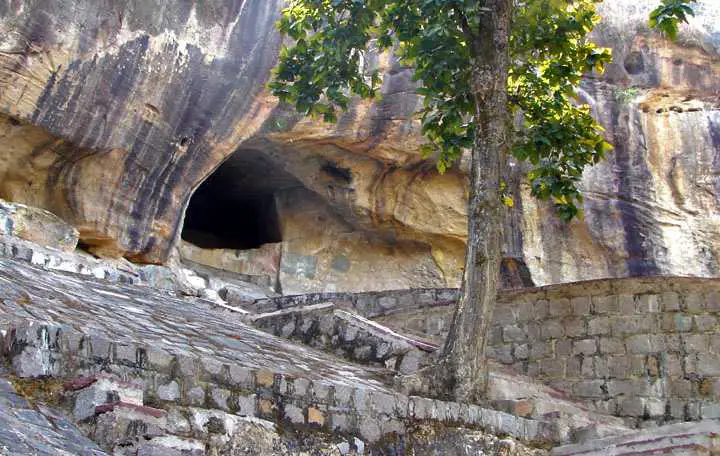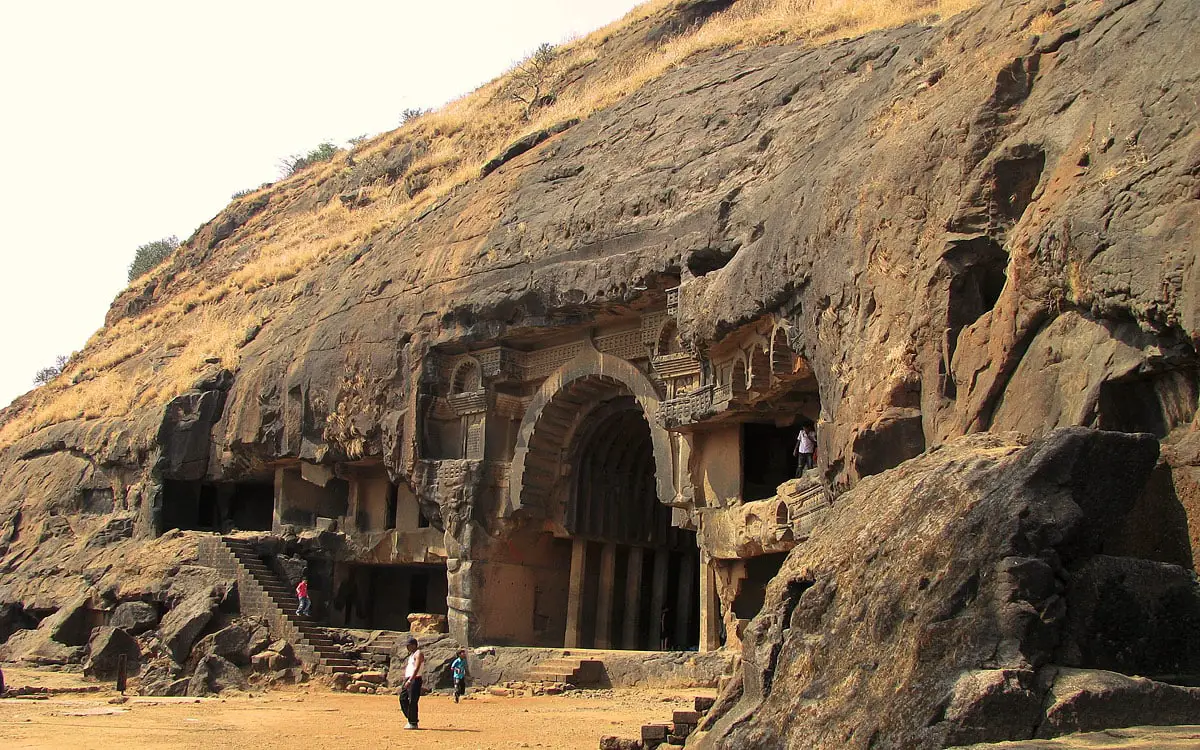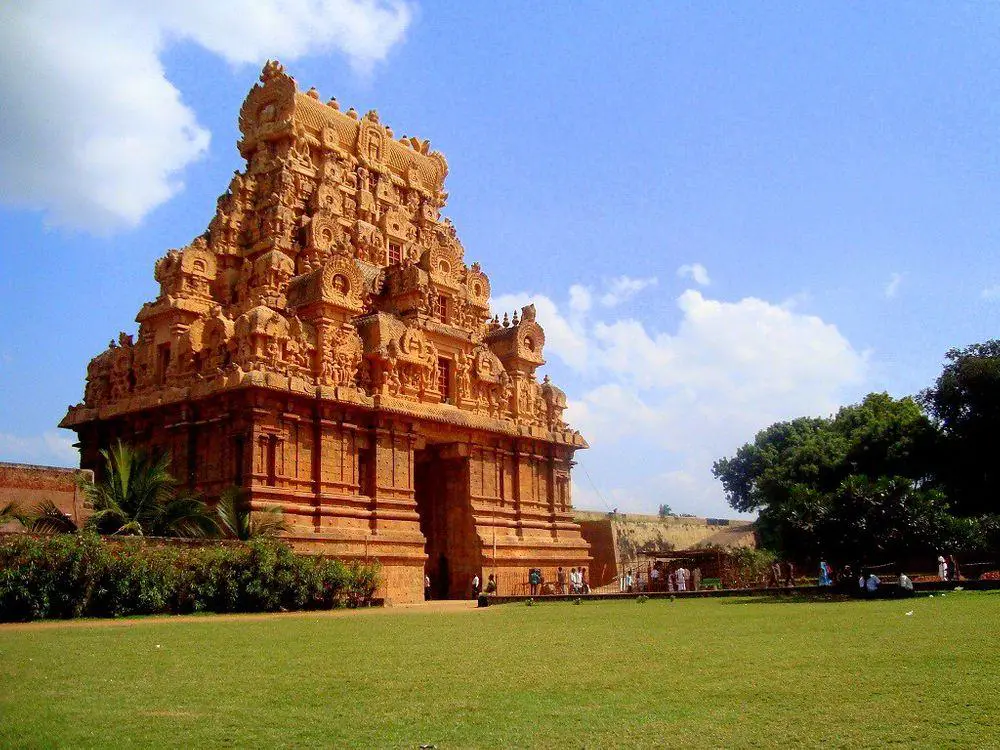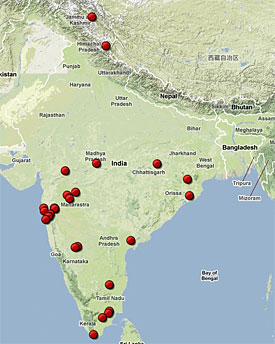World 🢖 Asia 🢖 India 🢖 Chhattisgarh
Operas, theatres and concert halls 🢔 Public buildings 🢔 Archaeological wonders 🢔 Categories of wonders
Wonder
Jogimara Cave, Sita Bengra Cave

 In short
In short
Although India is a country of miracles and surprises, Jogimara Cave and Sita Bengra Cave is miracle even by Indian standards.
Together with the nearby Sita Bengra cave it forms 2,300 years old performance stage – one of the oldest theatres in the world. Interior of Jogimara cave is covered with paintings and here is the oldest known love message in the world.
 46.8%
46.8%
GPS coordinates
Alternate names
Age
Map of the site
If you see this after your page is loaded completely, leafletJS files are missing.
 In detail
In detail
Surprise in the jungle
These caves are located in a beautiful natural setting, mountainous jungle massive. To add to the effect, both caves are reached through a natural tunnel. Even elephants can pass through this 55 m long tunnel – hence the name of this tunnel – Hathipol (Hatipal), “Elephant Cave”.
At the west, after passing this tunnel the hillside forms a steep crescent, rising above a wooded valley. Further to the west, there rises another hill.
Both Jogimara and Sita Bengra Caves open to the west – Sita Bengra is located further to the north and Jogimara – to the south.
According to legends during their exile in these caves hid heroes of Ramayana epos – brothers Laxman, Rama, and wife of Rama – Sita. Hence comes the name Sita Bengra – “Residence of Sita”.
Sita Bengra – ancient theatre
This beautiful, secluded site is known to Europeans since 1874 – 1875. Although now it is somewhat remote, most certainly it wasn’t a silent place 2,300 years ago.
It seems that this secluded, beautiful valley was a well-known site where gathered poets and their spectators. This place seemingly was especially popular during the spring nights with a full moon when the great festival of Kama – a deity of love – took place.
The semi-circular valley with both caves in the background formed a fine amphitheater, similar to ancient Greek theatres. In the front of Sita Bengra cave, there are round rock-cut benches, arranged in terraces in the shape of a crescent, with aisles. In total, this amphitheater had some 50 seats which partially blocked the entrance in the Sita Bengra Cave and provided a sight over the performance below. The stage was carved out of the cliff as well.
The cave is 14 m long, 5 m wide, and 1.8 m high in forepart. It seems that there was a gallery for some high ranked (royal?) family as well – a stone cut platform in front, located lower than the gallery.
In the floor in front of the cave there are hewn two holes – possibly here were placed poles which held a curtain shielding the visitors from the winds in winter nights. In the right corner, in front of the cave, there are made also human footprints.
Sita Bengra Cave itself is a natural cave with a rock-cut small hall resembling a stage.
Some speculate that even the famous lyric poem “Meghadūta” was written by the great Sanskrit poet Kālidāsa here or nearby. According to some theories, this famous poet lived nearby sometime in the 4th – 6th century AD.
The cave contains a faint two-line inscription. It tells about venerable poets who kindled the hearts of local society and that these poets “tie garlands thick with jasmine flowers around their necks”. The inscription refers also to the vernal full moon and some event – perhaps, spring festival abounding in frolics and music.
Jogimara Cave – dressing room?
Jogimara Cave is smaller than Sita Bengra, it is just 3 x 1.8 x 1.8 m large, artificially carved rock chamber. This is a dry cave with a wide entrance, the entrance part creates an intimate, discrete environment.
It is considered that it served as a resting place for the girls employed in theatre.
This otherwise small cave contains monuments of the art of world importance – paintings and inscriptions.
Paintings of Jogimara
Around the 1st century BC, the walls and ceiling of this cave were adorned with exquisite paintings – and this is the oldest known deliberate attempt to beautify premises with previously planned painting.
The paint was laid on white base plaster although in some places the paint had been laid also on the unprepared base.
The painting was done in two layers – the original by an expert artist in the 1st century BC and the latter by another artist, in inferior quality. Drawings were made in lines. Red, black, white, and yellow colors were used. Each painting has a red outline.
For the most part, paintings seem to have little in common with religion – what is a difference from other Indian cave paintings of the historical period.
At the root of this cave, there are seven paintings of human, fish, and elephant figures. Shown also a dancing couple near a lily flower, doll-like image, singers and dancers with a female dancer. Unclear chariot paintings, birds, animals shown as well.
Some saints have been painted here as well.
Inscriptions of Jogimara
As if paintings were not enough, this small cave contains also the first documented messages of love in the world. This faded inscription tells about the intense love between Sutnuka and Devdutta. It seems that Devdutta (man) used to watch Sutnuka (girl) dancing in the theatre – and this man was obsessed with the actress.
This five-line inscription has been written in Brahmi script and it tells “Sutanuka by name, a devadasi, the excellent among young men, Devadinna by name, the rupadaksha, loved her.
There is also another translation for this inscription:
“Sutanuka by name, a devadasi, made this testing place for girls (local actresses?). Devadinna by name, skilled in painting/ calligraphy, made the paintings in this cave”.
This is the first time when the term “devadasi” is mentioned. It is even considered that this theatre was one of the cultural centers where Devadasi tradition originated. Initially, devadasi – young and specially selected girls were “married” to deities and served in the temple, living in celibate and performing religious rituals. These girls were taught classical arts and traditions and initially had a high esteem and social status. They themselves were creating the traditions and artistic and musical styles. Much later this tradition though was hugely degraded.
Jogimara Cave is included in the following list:
 Linked articles
Linked articles

Rock-cut architecture and sculptures
Rock-cut architecture is a very ancient form of architecture – the oldest structures are more than 5 thousand years old. The resistivity of the natural stone and the constant climate inside these structures has preserved many art values around the world.

Wonders of India
India is the seventh-largest country in the world by area, and, naturally, such a large area contains a huge amount of exciting attractions…
Wondermondo considers that India is the second richest center of architectural heritage in the world after Europe and maybe no single country in the world can match it in this respect.

Hindu shrines
Hinduism is one of the oldest religions – possibly the oldest one among contemporary religions and Hindu temples belong to the most impressive religious buildings in the world.
 Recommended books
Recommended books
India Unveiled: Spirit, Tradition, People
This is the one book you need to understand the spirit of India. Internationally acclaimed as the best book of its type on India, this sixth expanded, revised edition of the multi-award-winning book India Unveiled: Spirit, Tradition, People by Robert Arnett truly reveals the diversity and sacredness of the oldest continuously living civilization on earth.
India: A Sacred Geography
A spiritual history of the world’s most religiously complex and diverse society, from one of Harvard’s most respected scholars.




<p>very good information share about <a href=”https://www.studynotesbook.com/jogimara-gufa/”>Jogimara cave</a>.</p>